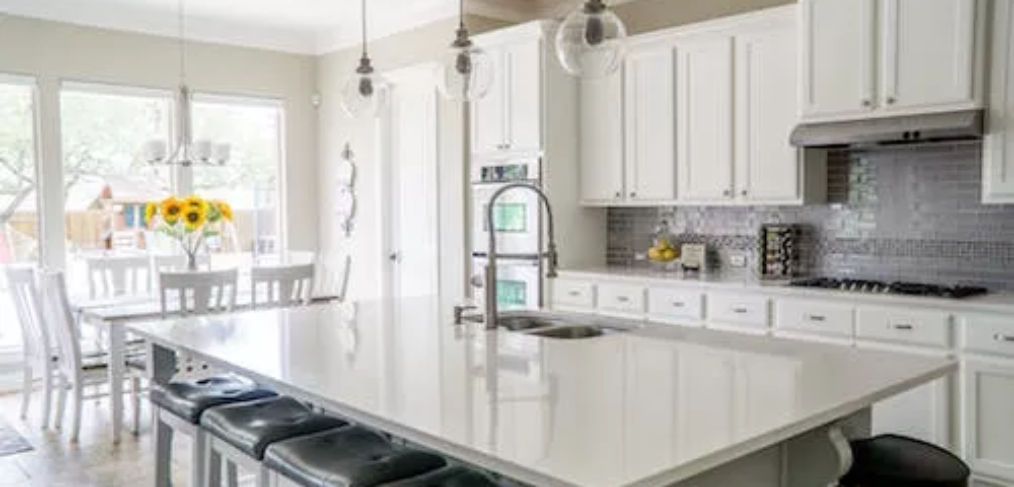Upgrading or improving your home can be one of the most rewarding activities you could undertake — and that includes monetarily, because depending on the improvement, you can boost your home’s value and recoup some of your investment when the time comes to sell. However, it’s important to remember that upgrading your house isn’t exactly a dollar-for-dollar investment; you probably aren’t going to make all of your money back that you sunk into the improvement, so pumping $5,000 into your kitchen and then expecting to just tack on an additional $5,000 to your listing price when you sell it is very likely unrealistic.
Which home improvements result in the highest return when it comes time to sell? There are several that are likely to generate at least a small increase in your home’s value — but before you decide what to do, think about how long you’re likely to stay in the house and which upgrades you’ll get the most enjoyment from before you start renovating. That way you won’t be expecting a 1:1 (or higher) return, and if you’re focused on improving your own lifestyle and maybe making some memories with your household, you’ll be picking the wisest upgrades and increasing your home’s future listing price at the same time.
Kitchen rules
It’s still very true that the kitchen is the heart of the home, and for that reason, kitchen upgrades tend to be some of the best improvements you can make in terms of increasing your home’s value. Plus, depending on what you’re doing in the kitchen, the upgrades tend to be much more flexible or forgiving in terms of your overall budget than other rooms in the house — you can pretty easily sink thousands of dollars into a kitchen, of course, but it might be pleasantly surprising to discover just how much you can get for a few hundred dollars.
On the cheaper side, one way you can brighten up your kitchen is to replace the cabinet doors and paint the cabinets. There are really no rules as to what you should do, except one big one: Following trends usually dates your kitchen pretty quickly (remember the “tuxedo” cabinet craze a few years back?), so try to go with something classic. Plain dark or light wood tends to work well when you’re updating cabinet doors, or pick a color that meshes with the rest of your decor for the paint. Adding a backsplash instead of plain paint can also be an easy way to upgrade your kitchen on the cheap side.
And then there are the more expensive upgrades, like replacing your formica or laminate countertop with tile or even granite or quartz. This will require more of a monetary investment, but it can elevate your kitchen’s look (and the price of your home), so it’s worth considering if you’re sick of your kitchen counters and want something different. Talk to your contractor or even call up your real estate agent to ask what they think about your options — it might be tempting to go with another trendy material, like concrete, and these people can tell you if the trend will have staying power or if you should just stay away.
Appliance upgrades are also definitely not on the cheap side, especially if you’re going to upgrade everything in the kitchen from the range to the dishwasher to the fridge. But if your appliances are looking tired and you’ll get a little use out of the new ones before you decide to sell, it can be well worth the investment. Pick something you like, of course; even though stainless steel appliances aren’t exactly new, they’re new enough that they can give your entire kitchen an “updated” look with mid-range appliances, which can do quite a bit for the sales price of your home.
Bathrooms matter
Although most of us don’t spend quite as much time in the bathroom as we do the kitchen, it can still pay off to drop some home-improvement dollars on your bathrooms to update them, especially if it’s been a while and they’re looking tired. Replacing cabinets and countertops is sometimes a good idea in the bathroom, too, or updating the mirror (especially with a bigger option) to brighten up the room.
If your house doesn’t have any bathtubs, adding a tub is often a big winner in terms of home improvement — especially if you have a fancy tankless water heater or another option that will ensure plenty of hot water for the baths. Jacuzzis have more or less fallen out of fashion, but long, deep tubs where even a tall homeowner can stretch out and relax are always a good investment.
Re-tiling the shower (or upgrading to tile from a fiberglass version) can also make your bathroom look much better, and installing a new showerhead (or even two if your shower can accommodate them) is a worthy improvement that both you and a future buyer can both appreciate.
Finish a basement
Adding livable square footage is one of the easiest ways to boost your home’s value instantly — even if that basement is technically already part of your house, if it’s not finished, then it doesn’t count toward the gross living area (GLA), which is one important way that appraisers and agents calculate value. You might not be able to add a full bedroom (which requires an “egress” — either a second door or a window that should open to the outside), but if you can turn your basement into a home gym, a second living area, an office, or a movie theater space, then you’ll be able to claim all that square footage as GLA.
…Or add an attic bedroom
If your attic already has a window and is accessible via stairs or a ladder, then all you need to do to create an attic bedroom is to finish your attic and maybe add a closet in some states. This can also add GLA to your house, not to mention the perks of having an extra bedroom, whether that’s for your own household members or for a private bedroom rental on Airbnb. You might want to talk to a general contractor about how easy this upgrade will be to implement, but if they say it’s possible, then you’ll be able to claim an additional bedroom when the time comes to list your house — a big perk.
Think green
Many buyers are prioritizing environmentally friendly, low-cost homes that make the most of energy efficiency; if you’ve had an energy audit done on your house and have a list of recommendations, then this could be a good place to sink any extra money you might have to throw at a home improvement. Some common suggestions include replacing or upgrading the insulation, replacing windows and even external doors, and (depending on the area) potentially adding solar panels.
That said, solar panels can be a hit-or-miss home improvement in terms of investment. Some plans ask the homeowner to pay off the solar panels month by month over a matter of years, and if your panels aren’t fully paid off by the time you decide to sell the house, then some buyers might balk at the idea of continuing to sink their own money into what was essentially your improvement. That attitude might not make sense to you, but if it’s possible, buy your solar panels outright so you can include them as part and parcel of the house when the time comes to sell it.
Paint
Inside and out, there’s almost nothing that makes a house look instantly nicer and brighter than a fresh coat of paint. Choose a high-quality paint type and experiment with colors; there are all kinds of tech tools, including apps, that allow you to try out a new paint color and decide whether you like it before you dive in and invest in enough paint to capture all your rooms.
And speaking of outside, don’t forget about any porches, decks, or fences that might require a little paint face-lift. A fence with chipping, flaking paint can make a house look tired and unkempt, so when you’re painting, make sure you include any features on the perimeter of your house, too.
Smart-home add-ons
Not everyone has an Amazon Alexa or Google Home device, but for those that do, there are plenty of items you can add to your home to make it a little “smarter” and easier to control by voice. Whether it’s a smart thermostat you can control with an app, a smart lock for your door that’s programmable to allow pet-sitters or house guests to walk on in, a light system that allows you to create a specific ambiance in your living room or bedroom, or any number of other additions, some buyers will definitely appreciate the fact that your home appears to sport the latest and greatest in technology.
The great outdoors
Adding a deck or an outdoor kitchen to your home doesn’t exactly increase your GLA, but it can be a huge selling point for future buyers, especially if you live in an area where the climate is pleasant and people tend to spend a lot of time outside. Another popular outdoor upgrade is landscaping, which can definitely add a lot of curb appeal to your home — just make sure that any landscaping you add is relatively low-maintenance and is acclimated to the weather where you live. Many younger buyers prioritize yards that are easy to maintain over the landscaped, golf-course-like expanses of grass that were popular a couple of decades ago, so if you’re going to upgrade the outside of your house, make sure you’re keeping them (and your own tastes, of course) in mind before you sink the money into your front or back yards.
Replace the floors
Your floors might be in impeccable shape, but if the carpeting is looking a little sad, or you’ve got a linoleum floor in the kitchen that hasn’t changed since the house was built, it could be time for you to splurge on some updated flooring that brings your house into the new century. Even if you’ve got some relatively new laminate flooring, if it’s starting to show some wear and tear, then upgrading it with a hardier material might be well worth your time — it’ll make your home look nicer while you’re there and increase the resale value when you’re ready to move on.
Think accessible
Our household configurations are changing in the United States, slowly but surely. To make your house appealing to buyers of all ages (or buyers with family members of all ages), one upgrade you can make that often pays off is making your home more accessible. Can you create a master suite with a bathroom on the main floor to eliminate the need for stairs? Can you add rails to the bathroom in the shower, bathtub, and toilet to make them safer? Widen doorways and maybe replace carpeting with hardwood flooring or laminate?
Whatever you can do to make your house more accessible to those with mobility issues will likely go a long way toward finding buyers who are interested in it down the road — and might even be able to help you with a family situation in the here and now.
Create a home office
More and more companies have remote work as an option for employees or even a fully distributed workforce, and their employees need a quiet, inspirational place to work at home if that’s part of their life. Even if it’s not, a home office can be a welcome addition to most households, whether it contains students who have homework or a family member who needs a little bit of space to go over the bills and organize the household on occasion. Some homes might not even require a full office; you might be surprised with what you can do with a little “laptop nook” with plenty of plugins and a wall-hanging desk to maximize space.
There are so many options when it comes to home improvement possibilities that it might seem hard to choose. Just remember that any upgrade you make needs to serve two main purposes: It should suit your current lifestyle in addition to (hopefully) boosting the resale value of your home. A full dollar-to-dollar return on your home sale investment probably isn’t likely, but when you factor in the enjoyment that you and your family will get out of any improvements, you’ll find that most of them are well worth what you’ll spend — and then some.





